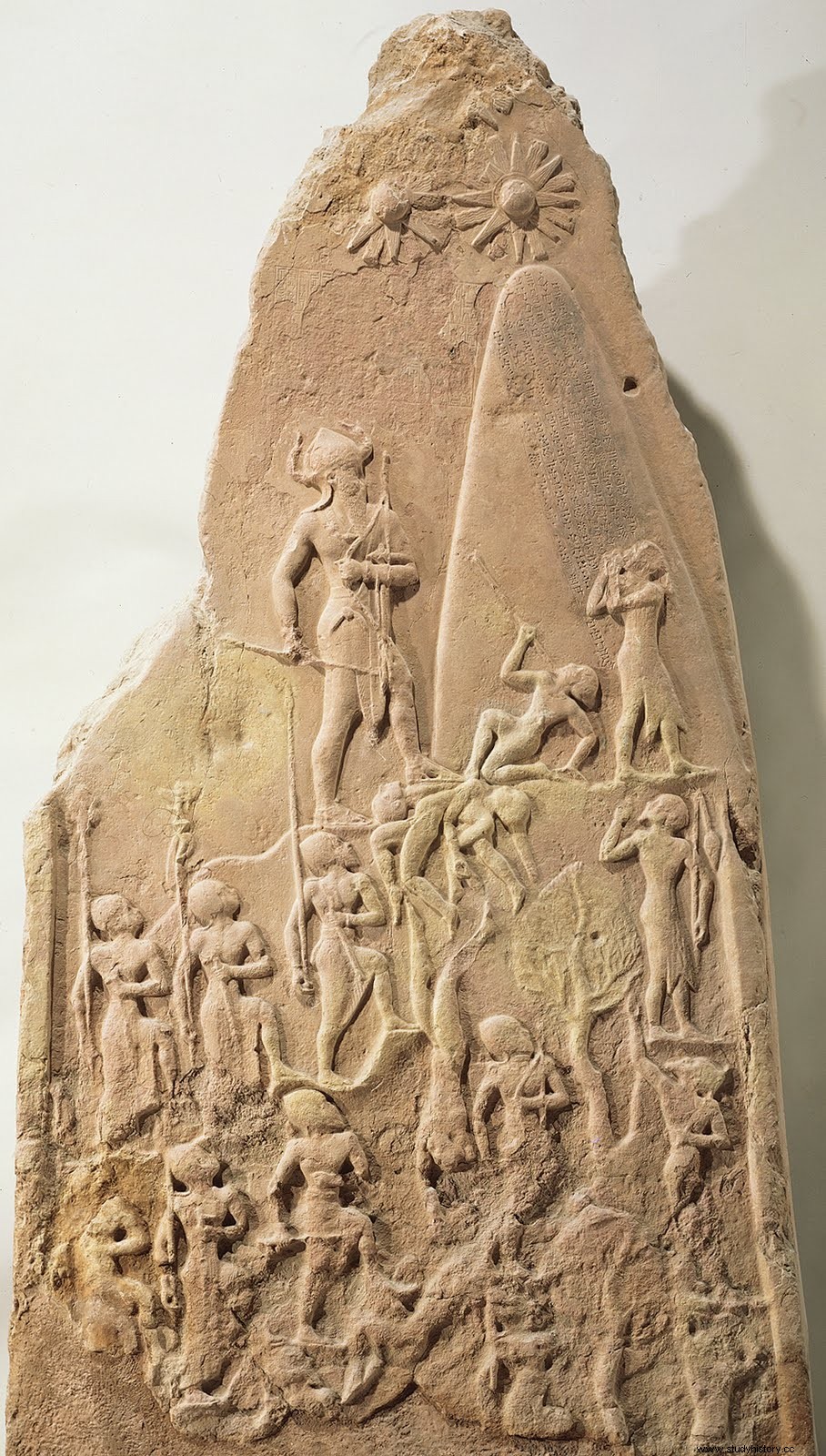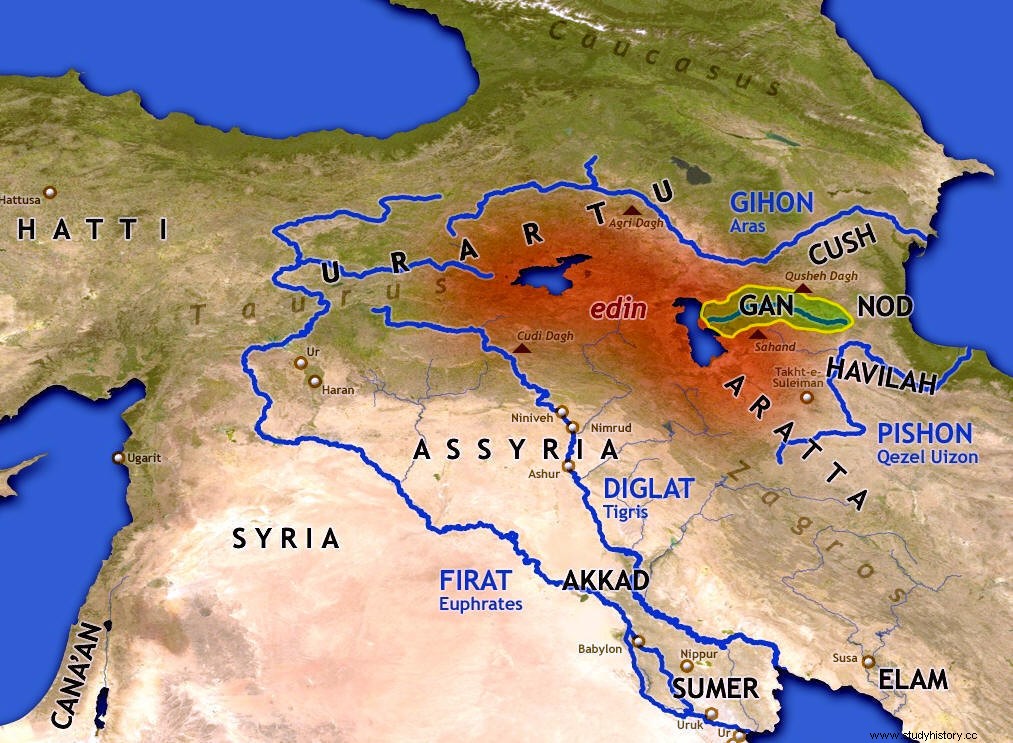The first known empire of humanity was the Akkadian, founded by Sargon of Akhad . Naram-Sin , his grandson, was a worthy successor in terms of conquests, because having lost the entire empire at the beginning of his reign, due to a civil war, he managed to recover it and increase the borders at the cost, yes, of passing to posterity as a great conqueror but a lousy ruler, as he caused the empire to end up plunged into economic, social and demographic ruin. One of the memories that remain of him is an object preserved in the Louvre Museum, specifically, the Stele of Naram-Sin . This beautiful sandstone carving has become famous in recent years thanks to the fact that many ufological media expose it as an example that there were UFOs in ancient times. The monarch would be, according to these media, observing two UFOs on high.

It is curious that these media have not fallen into the innocent detail that there are two cuneiform texts on the stela. One of them explains that the object commemorates the victory of the Akkadian king over the mountaineers lullubis . The two "UFOs" are simply representations of the gods to whom the military campaign was dedicated, since the temples on duty covered the expenses of the administration. The best preserved is clearly the star of Shamash (the sun god) and the damaged one seems to be that of Ishtar (goddess of war, sex and love). Over the years the stele has epitomized Akkadian military might, but in recent times various historians have begun to see that there is something odd about it. We assume that it is a typical piece of self-aggrandizement by an ancient monarch. The king is taller, more handsome, braver than anyone, and he didn't know the list of Gothic kings backwards and forwards because it hadn't been invented yet. But something is definitely not quite right. The first anomalous element would be the duration of the campaign:some versions point to five years; others something else. Naram-Sin conquered all Ebla (Syria and part of southern Turkey), with 17 cities including one with a triple wall (Armanum ), in less time. He swept from present-day Syria to Gaza in even less. He subdued the Elam in a single battle. The lullubis they were mountaineers who lived in what are now the Montes Zagros , on the border between Iran and Iraq. Five years to conquer that little piece of land? To top it off, he didn't kill Satuni , the lullubi king. He signed a friendship treaty with him, which is also amazing because the Akkadian loved to cut throats. He left a trail of more than 40 dead rulers. And more incredible is that, apparently, the Akkadians did not know the name of the Lullubi capital, nor its location, unlike in other cases. Today, because of this, we have no idea where it was located. We know that Naram-Sin it was something of a liar. In his wake of Mount Taurus he claims to have killed 17 Eblaite kings , but thanks to the actual Ebla library we know that, except for two, the rest were simple governors… or even less. The Akkadian liked to exaggerate.

All this makes us imagine a different panorama than the one the monarch wants us to see in the wake. The Zagros Mountains they are very steep, and in Akkadian times, moreover, they were covered by great and thick forests of cedars and conifers. Let us imagine a triumphant army that advances through unknown terrain, of which it does not know where the cities are, nor the points of trough. Soldiers trained to use two percussion weapons, the infantry phalanx and the compound bow , but who see that they are useless in steep, wooded and abrupt terrain. Warriors who go hungry because they don't know where the food is, and who are ambushed day and night by enemies armed with throwing axes who know the terrain perfectly. What does this remind us of? A name comes to mind:Vietnam . All great empires had a bad day, an Achilles heel. Apparently, the lullubis they were the bone that choked the Akkadian war machine. After years of casualties, suffering, expenses, and not even knowing how far away the enemy capital was, the Akkadian king opted to do the paripé:sign a non-existent treaty or just a piece of paper, give him some pat your colleague Satuni and walk away whistling while claiming that Paris is beautiful in spring . It is not the first case in antiquity in which an absolute monarch erects a monument to hide a sore callus.
This tells us several things :that there is no small enemy and the Kurds are tough people, since they are thought to be the descendants of the Lullubis; that even failures can produce a beautiful work of art; that we should not believe everything that an absolute monarch says and, even less, if he shows us with a marked love for exaggerated proportions (tell me what you brag about…); and, of course, that even if you have two UFOs on your side, you can still have a bad day.
Contributed by Joshua BedwyR
